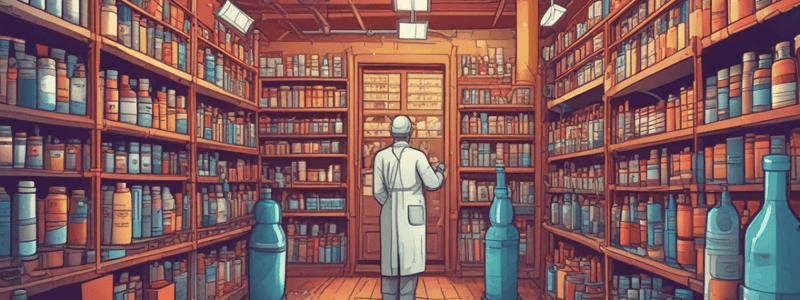Podcast
Questions and Answers
What is the relationship between stress and strain in a linear relationship?
What is the relationship between stress and strain in a linear relationship?
Directly proportional
What is the physical property represented by the reciprocal of the slope of the line in a linear relationship between stress and strain?
What is the physical property represented by the reciprocal of the slope of the line in a linear relationship between stress and strain?
Viscosity (ŋ)
What type of fluid does not exhibit a linear relationship between stress and strain?
What type of fluid does not exhibit a linear relationship between stress and strain?
Non-Newtonian fluids
What is the characteristic feature of plastic fluids?
What is the characteristic feature of plastic fluids?
What is the mechanism behind the flow of plastic fluids?
What is the mechanism behind the flow of plastic fluids?
What is the characteristic feature of pseudo-plastic fluids?
What is the characteristic feature of pseudo-plastic fluids?
What is the mechanism behind the flow of pseudo-plastic fluids?
What is the mechanism behind the flow of pseudo-plastic fluids?
What type of fluid exhibits an increase in viscosity when subjected to shear stress?
What type of fluid exhibits an increase in viscosity when subjected to shear stress?
What does the term 'rheology' describe?
What does the term 'rheology' describe?
What happens to the viscosity of a thixotropic material when shear stress is applied?
What happens to the viscosity of a thixotropic material when shear stress is applied?
What type of fluids are dilatant fluids?
What type of fluids are dilatant fluids?
What is the force per unit area that causes fluid movement?
What is the force per unit area that causes fluid movement?
What measures the resistance of a fluid to flow?
What measures the resistance of a fluid to flow?
Why is thixotropy a desirable property in pharmaceutical applications?
Why is thixotropy a desirable property in pharmaceutical applications?
What is the relationship between stress and strain in a Newtonian fluid?
What is the relationship between stress and strain in a Newtonian fluid?
What is the relation between thixotropy and the stability of suspensions?
What is the relation between thixotropy and the stability of suspensions?
What is the characteristic of a fluid with a non-linear relationship between stress and strain?
What is the characteristic of a fluid with a non-linear relationship between stress and strain?
How does temperature affect the viscosity of liquids?
How does temperature affect the viscosity of liquids?
According to Newton's assumption, what is the relationship between force and flow rate in a fluid?
According to Newton's assumption, what is the relationship between force and flow rate in a fluid?
How does temperature affect the viscosity of gases?
How does temperature affect the viscosity of gases?
What is the effect of molecular size on viscosity?
What is the effect of molecular size on viscosity?
What happens to the viscosity of a thixotropic material when the stress is removed?
What happens to the viscosity of a thixotropic material when the stress is removed?
Flashcards are hidden until you start studying
Study Notes
Rheology
- Rheology is the study of the flow of liquids and the deformation of solids
- It is involved in the mixing and flow of materials, their packaging, and the pouring from containers
Flow
- Flow occurs when stress is applied to a material
- Stress is the force per unit area, and strain is the amount of deformation caused by the shear stress
- Viscosity is the resistance of gases or fluids to flow due to shear stress
- Fluidity is the inverse of viscosity, and the slope of the line on a graph is fluidity
Materials (Fluids)
- Newtonian fluids have a linear relationship between stress and strain
- Non-Newtonian fluids have a non-linear relationship between stress and strain
Newtonian Fluids
- Newtonian fluids have a viscosity that is independent of the shear rate
- The slope of the line on a graph is viscosity (ŋ)
Non-Newtonian Fluids
-
Plastic fluids have a yield value, which is the minimum shear stress required for the material to deform and begin to flow
-
Yield value affects the quality of creams, such as a skin cream
-
Mechanism: a certain force is needed to break the bonds between particles before it starts to flow
-
Pseudo-plastic fluids (Shear Thinning fluids) have a high viscosity at rest but flow immediately after shaking (stress)
-
Mobility and viscosity change along the line
-
Mechanism: polymer chains or building blocks of the substance rearrange and orient according to the direction of the applied force, decreasing viscosity and increasing flow
-
Dilatant fluids (Shear Thickening fluids) have a viscosity that increases with stress
-
Suspensions with high solid content (usually more than 50%) usually have this property
-
Mechanism: sudden formation of vacuum gaps in between cluster of material particles, leading to an increase in viscosity and decrease of flow
Thixotropy
- Thixotropic materials have a time-dependent reversible viscosities
- They are shear thinning materials that return to their pre-shear conditions when stress is removed
- The decrease in viscosity with application of stress is also time-dependent
- This property is useful in pharmaceutical applications, such as in suspensions and emulsions for sustained drug delivery systems
Factors Affecting Viscosity
- Intrinsic factors: molecular size, particle shape, and intermolecular forces
- Extrinsic factors: temperature and additives
- Viscosity of liquids decreases with temperature, while viscosity of gases increases with temperature
Studying That Suits You
Use AI to generate personalized quizzes and flashcards to suit your learning preferences.


